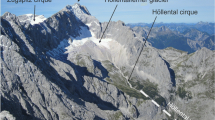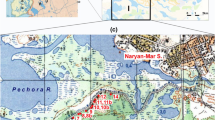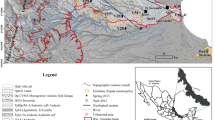Abstract
A radioisotope tracer (82Br) was injected into a sand aquifer adjacent to a tidal creek at Hat Head, New South Wales, Australia. The injection was timed to coincide with the falling limb of a spring tide in August 2001 and was repeated in July 2002 during a period of neap tides. The tracer movement was detected using gamma logging and fixed gamma detectors in a bore 0.9 m from an injection bore and in a line approximately perpendicular to the creek. Movement of the tracer was detected by comparing measured gamma activity with calibrated activities determined under laboratory conditions. Net movement of the tracer indicated approximately 0.001 m/day laterally towards the creek and 0.07 m/day vertically upward during spring tide conditions. This pattern is reversed during neap tide conditions with little net vertical movement but horizontal movement of 0.15 m/day. The measurements indicated an oscillatory motion coinciding with the tide but lagging the tide by approximately 4.5–6.5 h. The vertical flow during spring tides indicates that vertical movement of the saline interface occurs and results in mixing of different water types beneath the banks of the creek.
Résumé
Un traceur isotopique radioactif (82Br) a été injecté dans un aquifère sableux bordant une crique soumise à l’influence de la marée, à Hat Head (Nouvelles-Galles du Sud, Australie). L’injection fut programmée afin de coïncider avec la phase descendante d’une marée de vive-eau en août 2001, puis répétée en juillet 2002 en période de marée de morte-eau. Les mouvements du traceur étaient suivis à la fois par la réalisation de diagraphies d’activité gamma et par des détecteurs gamma fixes, dans un piézomètre situé à 0.9 m d’un forage d’injection et sur une ligne approximativement perpendiculaire à la crique. Ces mouvements étaient détectés par comparaison entre les activités gamma mesurées et les activités calibrées déterminées en laboratoire. Le mouvement net du traceur en conditions de vives-eaux indique une vitesse latérale de l’ordre de 0.001 m/jour en direction de la crique, et une vitesse verticale ascendante de 0.07 m/jour. Cette tendance s’inverse en conditions de mortes-eaux, avec un faible mouvement vertical, mais un mouvement horizontal de 0.15 m/jour. Les mesures mettent en évidence un mouvement oscillatoire coïncidant avec la marée, avec toutefois un décalage de 4.5 à 6.5 heures environ. Le flux vertical observé au cours des marées de vives-eaux indique l’existence d’un mouvement vertical de l’interface eau douce / eau salée, qui génère un mélange des différents types d’eau sous les rives de la crique.
Resumen
Un radioisótopo trazador (82Br), se inyectó en un acuífero de arena, adyacente a un canal de marea en Hat Head, New South Wales, Australia. La inyección fue sincronizada para coincidir con la parte descendente de una marea viva en agosto de 2001 y se repitió en julio de 2002, durante un periodo de mareas muertas. El movimiento del trazador fue detectado mediante el uso de registros gamma y detectores gamma estáticos, en una perforación a 0.9 m de una perforación de inyección y en una línea aproximadamente perpendicular al canal. El movimiento del trazador se detectó, comparando la actividad gamma medida con las actividades calibradas determinadas bajo condiciones de laboratorio. El movimiento neto del trazador indicó aproximadamente 0.001 m/dia lateralmente hacia el canal y 0.07 m/dia verticalmente ascendente durante las condiciones de mareas vivas. Este modelo se invierte durante las condiciones de marea muerta, con pequeño movimiento vertical neto, pero con un movimiento horizontal de 0.15 m/d. Las mediciones indicaron un movimiento oscilatorio coincidiendo con el tipo de marea, pero retrasándose a la marea por aproximadamente 4.5–6.5 horas. El flujo vertical durante las mareas vivas, indica que el movimiento vertical de la interfase salina ocurre y produce mezclas de tipos de agua diferentes, bajo los bancos del canal.
















Similar content being viewed by others
References
Acworth RI, Andersen MS (2004) Geochemical evidence of freshwater discharge patterns and mixing near a tidal creek, Hat Head, Australia. In: Carrillo (ed) Groundwater flow understanding: from local to regional scales, CD, IAH, http://www.IAH.org
Acworth RI, Dasey GR (2003) Mapping of the hyporheic zone around a tidal creek using a combination of borehole logging, borehole electrical tomography and cross-creek electrical imaging. Hydrogeol J 11.3:368–337
Acworth RI, Soriano R, Turner IL (2000) The vertical head distribution in a coastal sand-dune aquifer. In: Sililo (ed) Groundwater: past achievements and future challenges. Balkema, Rotterdam, pp 67–72
Andersen MS (2001) Geochemical processes at a freshwater-seawater interface. PhD Thesis, Technical University of Denmark, Kgs. Lyngby
Apelo CAJ, Postma D (1993) Geochemistry, groundwater and pollution. Balkema, Rotterdam
Barlow PM (2003) Ground water in freshwater-saltwater environments of the Atlantic Coast. Circular 1262, US Geological Survey, Reston, VA
Barnes K, Ellery W, Kindness A (2002) A preliminary analysis of water chemistry of the Mkuze Wetland System Kwa Zulu-Natal: a mass balance approach. Water SA 28:1–12
Charette MA, Splivallo R, Herbold C, Bollinger MS, Moore W (2003) Salt marsh submarine groundwater discharge as traced by radium isotopes. Mar Chem 84:113–121
Drost W, Klotz D (1983) Aquifer characteristics, in Guidebook on Nuclear Techniques in Hydrology, IAEA Technical Report Series No. 91, IAEA, Vienna, pp 223–256
Gaspar E (1987) Tracer methodology in hydrology. In: Gaspar E (ed) Modern trends in tracer hydrology. CRC Press, Boca Raton, FL
Happell JD, Price RM, Top Z, Swart PK (2003) Evidence for the removal of CFC-11, CFC-12, and CFC-113 at the groundwater-surface water interface in the Everglades. J Hydrol 279:94–105
Hughes CE, Stone DJM, Acworth RI (2003) A radioisotope tracer study of estuarine groundwater movement on the eastern Australian coast. Isotope Hydrology and Integrated Water Resource Management, IAEA Conference, 17–23 May 2003, Vienna
Nielsen P (1990) Tidal dynamics of the watertable in beaches. Water Resour Res 26(9):2127–2134
Nowicki WK, Requintina E, Van Keuren D, Portnoy J (1999) The role of sediment denitrification in reducing groundwater-derived nitrate inputs to Nauset Marsh Estuary, Cape Cod, Massachusetts. Estuaries 22:245–259
Oncescu M, Gaspar E, Dinescu L (1973) On the determination of some constants of the tracer dynamics in field investigations. Romanian J Phys 18:1023–1033
Philip JR (1973) Periodic non-linear diffusion: an integral relation and its consequences. Aust J Phys 26:513–519
Price RM, Top ZT, Happell JD, Swart PK (2003) Use of tritium and helium to define groundwater flow conditions in Everglades National Park. Water Resour Res 39.2
Soriano S (2004) Groundwater dynamics in coastal sand dune aquifers: the impacts of transient bouindary conditions. PhD Thesis, The School of Civil and Environmental Engineering, University of New South Wales, Sydney
Testa JM, Charette MA, Sholkovitz ER, Allen MC, Rago A, Herbold CW (2002) Dissolved iron cycling in the subterranean estuary of a coastal bay: Waquoit Bay, Massachusetts. Biol Bull 203:255–256
Turner IL, Coates BP, Acworth RI (1996) The effects of tides and waves to groundwater elevations in coastal zones. Hydrogeol J 4:51–69
Westbrook SJ, Rayner JL, Davis GB, Clement TP, Bjerg PL, Fisher SJ (2005) Interaction between shallow groundwater, saline surface water and contaminant discharge at a seasonally and tidally forced estuarine boundary. J Hydrol 302:255–269
Acknowledgements
Mark Groskops of the Water Research Laboratory is thanked for the assistance in the field and the installation of the monitoring points. Tom Kluss, Peter Airey, Suzanne Hollins, Adrian Mozjeko, Gordon McOrist, David Stone, Carol Tadros, Roland Wong and Gregor Büning are thanked for assistance with the tracer study design and implementation. The work was supported by an AINSE grant and by funding from Kempsey Council.
Author information
Authors and Affiliations
Corresponding author
Rights and permissions
About this article
Cite this article
Acworth, R.I., Hughes, C.E. & Turner, I.L. A radioisotope tracer investigation to determine the direction of groundwater movement adjacent to a tidal creek during spring and neap tides. Hydrogeol J 15, 281–296 (2007). https://doi.org/10.1007/s10040-006-0085-5
Received:
Accepted:
Published:
Issue Date:
DOI: https://doi.org/10.1007/s10040-006-0085-5




